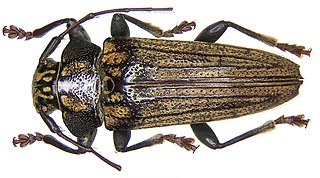
The large skipper is a butterfly of the family Hesperiidae.

Mushika dynasty, also spelled Mushaka, was a minor dynastic power that held sway over the region in and around Mount Ezhi (Ezhimala) in present-day North Malabar, Kerala, India. The country of the Mushikas, ruled by an ancient lineage of the Hehaya clan of the same name, appears in early historic (pre-Pallava) south India. Early Tamil poems contain several references to the exploits of Nannan of Ezhimalai. Nannan was known as a great enemy of the pre-Pallava Chera chieftains. The clan also had matrimonial alliances with the Chera, Pandya and Chola chieftains. The Kolathunadu (Kannur) Kingdom, which was the descendant of Mushika dynasty, at the peak of its power, reportedly extended from Netravati River (Mangalore) in the north to Korapuzha (Kozhikode) in the south with Arabian Sea on the west and Kodagu hills on the eastern boundary, also including the isolated islands of Lakshadweep in the Arabian Sea.

Ochlodes venatus is a skipper butterfly species in the family Hesperiidae. The name was long used for the large skipper of Europe, but it actually refers to its Far Eastern sister species and the large skipper is now called O. sylvanus. There is some dispute however about whether the large skipper should not better placed in O. venatus as a subspecies sylvanus or faunus. An ICZN Opinion in 1944 noted that the genus name Ochlodes is masculine, so the correct epithet for this species is venatus. However, many sources continue to list it as Ochlodes venata.

The battle of Kandalur salai, also spelled Kanthaloor shala, was a naval engagement of the Cholas under Rajaraja I against the "salai" at Kandalur in south Kerala. The exact location of Kandalur—somewhere south Kerala—is a subject of scholarly debate. The above event is sometimes assumed to be identical with the "conquest of Vizhinjam by a general of Rajaraja [I]", before the burning of Lanka, given in the Tiruvalangadu Grant/Plates.
Himantopterus is a genus of moths in the family Himantopteridae. It was described by Constantin Wesmael in 1836.
Mansory is a luxury car modification firm based in Brand, Germany. Besides luxury cars, they also work on supercars, luxury SUVs and custom bikes. The company was founded in 1989 by Iranian-British tuner Kourosh Mansory. His Munich-based workshop focused on modifications for British brands such as Rolls Royce and Italian brands such as Ferrari. By mid-2001, the company had grown out of its Munich workshop and moved to headquarters in Fichtelgebirge. The company currently operates out of a workshop in Brand, Germany.

Dixeia doxo, the black-veined white, is a butterfly in the family Pieridae and is native to southern Africa.

Ravivarman, styled Maharaja Ravivarman, Kulasekhara was the ruler of Venatu, with capital at port Kolambam (Quilon), southern India between 1299 – 1316/7. He – in all likelihood – was a descendant of the ancient Cheras through his father Jayasimhadeva and was the son-in-law of the Pandya ruler of Maravarman Kulasekhara. Ravivarman raided large parts of southern India in a short period by skillfully taking advantage of the weakening of the Pandya kingdom and the confusion prevailed after the Khalji raids (1311).
Epinotia nigrovenata is a species of moth of the family Tortricidae. It is found in Chile.

Tmesisternus venatus is a species of beetle in the family Cerambycidae. It was described by James Thomson in 1864.
Himantopterus caudata is a moth in the family Himantopteridae. It was described by Frederic Moore in 1879. It is found in Myanmar and Assam, India.
Himantopterus dohertyi is a moth in the family Himantopteridae. It was described by Henry John Elwes in 1890. It is found in India.
Himantopterus fuscinervis is a moth in the family Himantopteridae. It was described by Constantin Wesmael in 1836. It is found on Sumatra and Java and in Malaysia.
Himantopterus nox is a moth in the family Himantopteridae. It was described by Hering in 1937. It is found in India (Assam).
Himantopterus zaida is a moth in the family Himantopteridae. It was described by Edward Doubleday in 1843. It is found in northern India.
Himantopterus nobuyukii is a moth in the family Himantopteridae. It was described by Yasunori Kishida and Toshio Inomata in 1993. It is found on Borneo.

Herefordopterus is a genus of eurypterid, an extinct group of aquatic arthropods. Herefordopterus is classified as part of the family Hughmilleriidae, a basal family in the highly derived Pterygotioidea superfamily of eurypterids. Fossils of the single and type species, H. banksii, have been discovered in deposits of Silurian age in Herefordshire and Shropshire, England. The genus is named after Herefordshire, where most of the Herefordopterus fossils have been found. The specific epithet honors Richard Banks, who found several well-preserved specimens, including the first Herefordopterus fossils.
Lythrodes venatus is a species of moth in the family Noctuidae. It is found in North America.
Sphenophorus venatus, the hunting billbug, is a species of beetle in the family Dryophthoridae. It is found in Central America and North America.
Sphenophorus immunis is a species of beetle in the family Curculionidae. Because the type specimen could not be located, the name once was considered a junior synonym of Sphenophorus venatus of authors [being itself a misinterpreted name].







